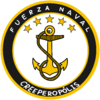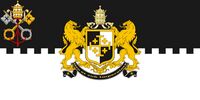Third Senvarian Insurgency
The Third Senvarian Insurgency was a civil military conflict which raged in Creeperopolis between the government and the Senvarian Liberation Front and Militarist Front for National Liberation. The war raged since October 5, 1934 and occured at the same time as the Mara War and Castillianan Insurgency.
The fully-fledged civil conflict lasted over 85 years and has been marked by war crimes, massacres, human rights violations, and crimes against humanity on both sides.[citation needed] It is unclear which side commits the majority of these crimes. The war was the deadliest ongoing global conflict and was the third of a series of Senvarian insurgencies.
On September 29, 2019, a Terraconserva Council of Nations Security Council resolution was submitted by Malgax to sanction Creeperopolis due to the ongoing conflict. It was vetoed by Quebecshire[1].
Background
Creeperopolis has historically been characterized by marked socioeconomic inequality, especially since industrialization. In the late 19th century, coffee became a major cash crop for Creeperopolis, bringing in about 95% of the country's income. However, this income was restricted to only 5% of the population, exacerbating a divide between a small but powerful land owning elite, the government, and an impoverished majority. This divide grew through the 1900s and 1910s due to the establishment of the National Coffee and Sugar Corporation (CORNACA), a coffee and sugar monopoly. Creeperopolis was so heavily reliant on coffee to keep its economy stable that a Quebecshirite economist, Gérôme Ballouhey, referred to Creeperopolis as a "coffee republic."[citation needed]
Corruption in the Creeperian government played a major role in the reason poverty in Creeperopolis skyrocketed during the early 1900's and on why the economy was so weak and unstable.
Emperor Adolfo IV fell ill to Creeperian Malaria in December 1932. Emperor Adolfo IV died on January 2, 1933 at 9:02am San Salvador Standard Time (SST). The news was given to both his sons, Romero and Miguel. Both soon declared themselves the next rightful Emperor of Creepeorpolis.
Hearing the news of Romero I declaring himself Emperor, Miguel VII ordered that the Creeperian Armed Forces immediately have Romero I arrested. Romero I did the same, and ordered the Creeperian Armed Forces to immediately arrest Miguel VII. The Creeperian Armed Forces quickly splintered into factions of the armed forces backing Romero I while the other half supported Miguel VII.
Romero I ordered the Armed Forces loyal to him to not attack soldiers loyal to Miguel VII for the time being. Miguel VII did the same, and ordered the Armed Forces loyal to him to not attack soldiers loyal to Romero I for the time being. However, at 7:23pm CST, soldiers loyal to Romero I encountered troops loyal to Miguel VII in a barrack in North San Salvador. Both forces were ordered to secure the barrack to prevent the other side from securing the weapons inside. At 7:25pm CST, firing began, and both sides started to fire on the other. The soldiers loyal to Miguel VII overran the soldiers loyal to Romero I and forced them to retreat the barrack. The soldiers loyal to Romero I took up positions one block from the barrack taking the city capitol turning it into their fortification. It remains a mystery who was the first to fire their rifle in the barrack.
The shots began the Creeperian Civil War, the deadliest war in Creeperian history.
Senvarians and Senvekians, after decades of Creeperian oppression, and after the Miguelists offered them an independent state if they fight and aid them against the Romerists, rose up against the Creeperian government on October 5, 1934, beginning the Third Senvarian Insurgency. The date falls on the 56th anniversary of the beginning of the Second Senvarian Insurgency in 1878.
War
Rise of the SLF
On October 5, 1934, Adam Schuessler I, a descendant of the Kings of Senvar-Senvek, the great great grandson of King William III, declared the establishment of the Republic of Senvar-Senvek. With his supporters, the Senvarian Liberation Front was founded to fight for and to maintain the sovereignty of the republic.
As promised, the Miguelists supported the republic and recognized its independence. It was also recognized by the by Miguelist puppet state of the State of Granada, part of the present-day Principality of El Salvador. Creeperopolis, El Salvador, Castilliano, Atlántida, and the State of the Church denounced the legitimacy of the republic.
The SLF took part in the Papal War.
In 1940, the Militarist Nationalist Front (FRENAMI) was established by Creeperian generals and soldiers. The group, nicknamed Sombra Negra, was a death squad which hunted down communists (Miguelists) and Senvarians (SLF forces). FRENAMI slowed down the SLF's advances as their members were being killed by FRENAMI vigilantes.
End of the Civil War
In 1949, the Miguelists surrendered to the Romerists, ending the Creeperian Civil War. The SLF, however, refused to surrender and continued a guerrilla insurgent war in southern Creeperopolis. FRENAMI also did not dissolve and continued to fight the SLF.
Salvadoran Revolution
While the Creeperian military was preoccupied by the Salvadoran Revolution of 1956, the SLF took advantage and began to conduct operations to sabotage Creeperian military activities.
Rise of MS and the FMLN
On October 15, 1979, Emperor Adolfo V declared war on the gang Mara Salvatrucha (MS) beginning the Mara War. MS allied itself with the SLF as Creeperopolis was seen as a common enemy.
On October 10, 1980, Farabundo Martí Rodríguez led a rebellion in death squad-controlled territory. He established the Militarist Front for National Liberation (FMLN) and allied with the SLF and MS to resist the Creeperian government, beginning the Castillianan Insurgency
October 16 Regime
Under Alfonso VI's October 16 Regime began to launch organized assassinations and murders of SLF, FMLN, and MS members, leading to an explosion in murder rates and violence.
Under Alexander II
Since the fall of the October 16 Regime, Alexander II has continued the war against the SLF, FMLN, and MS.
In August 2019, the SLF carried out the 2019 San Salvador Attacks which led to Alexander II declaring martial law. Murder rates exploded as a consequence.
Attempts for Peace
TCN Security Council Vote, 2019
On September 29, 2019 the Security Council of the TCN convened in Bostonia[2] to discuss the proposed Condemnation of Creeperopolis and the Suggestion of Sanctions[3].
During the session, the vote had become one in favor, four in opposition, and two abstaining before Quebecshire exercised veto authority[4]. Several votes have been lodged since, but as it stands the resolution will be discarded following the session's conclusion.
War Crimes
Both sides of the conflict have committed war crimes.
Creeperian War Crimes
Government War Crimes
| Incident | type of crime | Persons responsible | Notes |
|---|---|---|---|
| 1940 Huizúcar Massacre | Crimes Against Humanity, Genocide, Murder of Civilians | Gen. Adolfo Cabañeras Moreno | Resulted in the murder of 2,300 Senvarians. |
| 1943 Port Senvar Massacre | Crimes Against Humanity, Genocide, Murder of Civilians | Gen. Adolfo Cabañeras Moreno | Resulted in the murder of 1,300-1,500 Senvarians. |
FRENAMI War Crimes
| Incident | type of crime | Persons responsible | Notes |
|---|---|---|---|
| 1944 Denshire Massacre | Crimes Against Humanity, Genocide, Murder of Civilians, No-Quarter | Adolfo Rivera López | Resulted in 5,000+ Senvarians dead. |
Senvarian War Crimes
SLF War Crimes
| Incident | type of crime | Persons responsible | Notes |
|---|---|---|---|
| 1940 Talnique Massacre | Crimes Against Humanity, Murder of POW's | Adam Schuessler | Resulted in over 729 Creeperans dead. |
| 2019 San Salvador Attacks | Crimes Against Humanity, Murder of Civilians, Terrorism | Frederick Schuessler III | Resulted in over 150 Creeperans dead. |
FMLN War Crimes
| Incident | type of crime | Persons responsible | Notes |
|---|---|---|---|
| 1985 Tuxtla Martínez Massacre | Crimes Against Humanity, Murder of Civilians, Terrorism | Farabundo Martí Rodríguez | Resulted in 57 Creeperans dead. |
Mara War Crimes
| Incident | type of crime | Persons responsible | Notes |
|---|---|---|---|
| All Actions | Drug trafficking, robbery, larceny, human trafficking, extortion, murder, money laundering, prostitution, racketeering, battery, kidnapping, and arms trafficking | Alexander Ramírez Umaña | All actions are common crimes carried out by MS. Over 10,000+ dead. |
Deltinian War Crimes
| Incident | type of crime | Persons responsible | Notes |
|---|---|---|---|
| 2019 Rushdi Massacre | Crimes Against Humanity, Murder of Prisoners, Mass Murder, Terrorism | Kanaan el-Bashir | 530 killed. |







